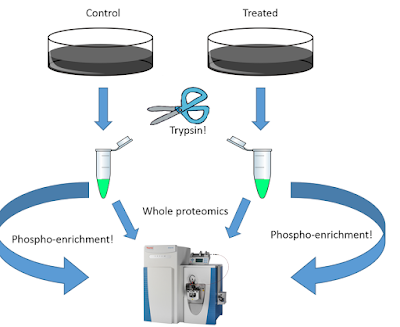28 Ağustos 2015 Cuma
Finally! One report for global and phosphoproteomics data!
As I mentioned in an earlier post, I've been working on a lot of things, but I haven't been finding a huge amount of success lately. I'd like to reverse that right now with maybe my favorite study I've ever set up.
Above, I made a quick PPT drawing for what I consider a typical simple phosphoproteomics experiment. Control cell line vs. treated cell line. Digest out the peptides. Run some of the peptides for global proteomics and enrich the rest for phosphoproteomics. Run it all on the same awesome high resolution instrumnet. Shouldn't you end up with data like this?
Okay, so what are we looking at here? This is a slice of a screenshot from a Proteome Discoverer 2.0 multiconsensus report. On the right we have accession numbers for the protein of interest. In the middle we have the exact side of phosphorylation within the protein(!!eek!! this one still makes me really happy!!) but even better is what is in the right column. We have 4 columns. The first 2 are the total relative area of the PROTEIN from the whole proteomics samples. The next 2 are the relative quantification of that phosphopeptide!!!!
Are you as excited as I am? Okay. Probably not. But check this out. The first one? When we treat with this drug we get up-regulation of the phosphorylation at Serine 83 in this protein of about 3 fold. That could be actual upregulation of the protein itself because we never detected this protein in the whole protein sample. But check out the last one in the screenshot. Phosphorylation on threonine 399 in this protein is upregulated following drug treatment by 5.2 fold but if we look at the total quantification of the peptides found for that protein (it doesn't show it here, but there are 7 of them!) the protein doesn't really look up-regulated. We've found a drug specific phosphorylation event! And this is in one PD 2.0 report.
I can't tell you how much I wish these functions existed during my postdoc...there aren't words.
So, how do you do it? It isn't easy. It took me...several... tries to get it exactly right. So good luck!!
Wait, just kidding. Why don't you watch this video and I'll show you how I did it.
As always, watch it in HD (once its available!). P.S. This is even better to set up in PD 2.1, but we'll talk about that later!
Kaydol:
Kayıt Yorumları (Atom)
Popular Posts
-
A recent paper in PNAS makes the statement in the title "Protein Carbamylation is a Hallmark of Aging. You can find it here . They find...





Hiç yorum yok:
Yorum Gönder